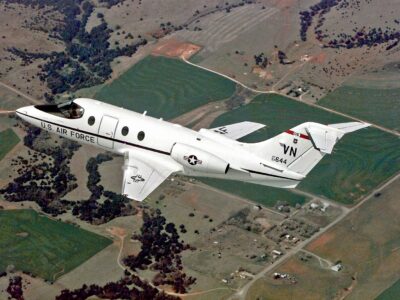
In this ongoing series, Thrust Tech Accessories (TTA) shines a light on the many different aircraft types presently in service around the world. Join us as we explore the roles they play in the industries they serve and the challenges they may see in performing their important duties day-by-day, year-after-year, all across the globe.
We also wish to underscore the key role that MROs like TTA play behind-the-scenes in providing overhaul, repair, and modification of engines and airframe accessory components that keep such aircraft flying properly, safely – and long into the future.
Gulfstream Aerospace is an all-American Success Story
Taking its first flight 65 years ago, Gulfstream’s GI introduced the aviation world to “the purpose-built business aircraft.” Accommodating up to 12 passengers, it could fly at up to Mach .54 speed and cruise at up to 30,000 feet with a range of 2,000 nautical miles.
“The GI launched a new chapter in aviation history and ultimately more than 200 GI aircraft took to the skies,” says Stanley Kowlessar, president and general manager, Thrust Tech Accessories (TTA), an FAA 145 and EASA Certified repair station provider of MRO services in Fort Lauderdale, Fla. “Incredibly, some of those GIs – the first of which went into service in 1959 – still remain in service today.”
Then in the mid-1960s, Gulfstream introduced the 16-passenger GII, which had a maximum speed of Mach .85, could fly at up to 45,000 feet and offered a 2,600-nautical-mile range. “The GII became the first business aircraft to cross the Atlantic Ocean,” notes TTA’s Kowlessar and “another interesting factoid is that two GIIs were purchased by NASA to train Space Shuttle astronauts.”
A New Chapter in Business Aviation
Opening the next Gulfstream chapter, the GIII took to the skies in 1979, and became the first business jet to fly over both poles. Introduced in 1985, the Gulfstream GIV revolutionized business aviation with its intercontinental range and advanced cockpit and cabin technology. That was followed a decade later by the ultralong-range Gulfstream GV.
“Certainly, a major step and exciting new chapter in the aircraft manufacturer’s history was Gulfstream’s acquisition by defense giant General Dynamics in 1999,” notes Kowlessar. In addition, Gulfstream subsequently acquired Galaxy Aerospace and rebranded Galaxy’s mid-sized aircraft as G100 and G200.
In the early 2000s, the Gulfstream G550 revolutionized the pilot experience in business aviation and won the 2003 Robert J. Collier Trophy, North America’s most prestigious award for technological achievement. That same year, the G450 also took to the skies – incorporating the G550’s technological advances into the popular Gulfstream GIV airframe. Most notably on the sustainability front, the G550 was the first business aircraft to fly across the Atlantic using biofuels.
In 2005, the eight-seat Gulfstream G150 flew for the first time, redefining the comfort and efficiency available in a mid-sized business jet. That also was the first business aircraft certified by the Federal Aviation Administration (FAA) for Stage 4 noise standards. Production of the G150 aircraft type ended in 2017, but many companies still operate those aircraft.
An Expert Gulfstream Service Provider
“Whatever Gulfstream airframe our customers operate, though, they can count on our expert MRO services and resources to keep their aircraft in tip-top shape,” Kowlessar emphasizes. “We have an eye toward cost-effectiveness and time-sensitivity, which we know are important to owners and operators. Every moment an aircraft is out of service costs our customers money, and we work tirelessly to find the best MRO solutions possible to help avoid unnecessary ground time.”
TTA provides expert service on a wide variety of items for Gulfstreams from generators, valves, and emergency batteries to hydraulic pumps, ignition exciters, starters, and more. The most popular part numbers are the following:
- PN: 28B421-2-C AC Generator
- PN: 978668-3-1 Shutoff Valves
- PN: 65166-01 Hydraulic Pump
Gulfstream Today
Today, Gulfstream Aerospace Corporation operates both an aircraft manufacturing facility and a separate research and development center in Savannah, Ga. Out of that R&D effort, for example, came the innovative Quiet Spike, a telescoping device that fits on an aircraft’s nose to effectively minimize the effects of breaking the sound barrier. In addition, Gulfstream also developed a Synthetic Vision-Primary Flight Display, a safety enhancement giving pilots an artificial view of the environment ahead.
“Together with parent company General Dynamics, Gulfstream continually invests in the future – researching and developing innovative new aircraft, technologies and services,” emphasizes Kowlessar. For instance, in 2009, Gulfstream introduced the intercontinental-range Gulfstream G280, resetting the standard for the super-mid-size aircraft class, and later the G650, which set a world speed record – flying westbound around the world in 41 hours, seven minutes.
Then in 2014, Gulfstream introduced its G650ER. “In 2019, that extended range aircraft shattered the speed record for the farthest business jet flight in history between Singapore and Tucson, AZ,” says Kowlessar, adding that “the G650 family also now holds FAA certification for steep approaches.” That opens up more airports globally for flight operations, most notably London City airport and Switzerland mountain airports.
Increasingly, companies are also evaluated for their sustainability efforts. Recently, Gulfstream became the first OEM to receive National Business Aviation Association (NBAA) Sustainable Flight Department Accreditations in all four available categories: flight, operations, ground support, and infrastructure. To date, Gulfstream has purchased more than two million gallons of sustainable aviation fuel (SAF).
The Latest Developments
In mid-2022, Gulfstream’s all-new, ultra-long-range business jet, the G800, took its first test flight. “It’s a speed demon and highly fuel efficient too,” notes Kowlessar, citing the aircraft’s Gulfstream-designed, advanced high-speed wing and an all-new, high-thrust Rolls-Royce Pearl 700 engines. In May 2023, the aircraft manufacturer also was in the midst of flight certification efforts for its new G700 aircraft.
Aviation Contributions
Looking at the overall picture of Gulfstream’s contributions to aviation, “today, more than 3,000 Gulfstream aircraft of various types are in service around the world,” explains Kowlessar. “That includes everything from the super-midsized G280, the high-performing G650 and the G650ER, plus the all-new Gulfstream G400, G500 and G600. Also, we in the aviation world look forward to such next generation planes as the G700 and ultralong-range G800.”
To assist Gulfstream owners and operators, TTA draws upon its 30-plus years of MRO experience, dynamic new ownership over the past five years, and an in-house team of experienced technicians and specialists. “Most notably, since the pandemic began, unlike some MROs, we’ve invested significantly in adding more MRO technicians, aviation specialists and technology experts,” he says. “We have also year-after-year significantly increased our parts inventory, plus added more PMA and OEM parts and DER solutions to assist our valued clients.”
In addition to assisting its customers resolve out-of-service situations with their aircraft, TTA also focuses on cost-effective preventive measures – to assure that owners and operators experience as little downtime as possible with their aircraft. So, if you own or operate Gulfstream aircraft, why not give TTA a call to discuss your business needs?
“We’re here to assist you,” notes Kowlessar. “And rest assured, we’ll be here in the future as those next generations of Gulfstream aircraft take to the skies too.”
PHOTO: Special thanks to Niklas Jonasson, Unsplash






